

Oyster Power Wave - Vague. Find out about the Oyster hydro-electric wave energy converter from Aquamarine Power home > waveSince November 2009, a demonstration-scale Oyster wave energy converter from Aquamarine Power has been exporting electricity to the National Grid from its site at the European Marine Energy Centre (EMEC) in the sea off Orkney.

Aquamarine Power have partnered with major utility company Scottish and Southern Power to co-develop up to 1,000MW of Oyster sites based around the next generation Oyster 2 commercial scale wave power device. A 2MW demonstration site will be built by 2011, and will be expanded to 10MW installed capacity by 2012. Oyster Wave Power The Oyster wave power device is designed to be used in water of around 10 metres depth 500 metres from coastlines to capture the energy found in nearshore waves, and convert it into clean renewable electricity. With half of the device attached to the seabed, the buoyant part is pushed backwards and forwards by the waves. Comment on this Article. World’s largest working hydro-electric wave energy device launched. Queen's University Belfast has helped the global wave energy industry take a major stride forward with the launch of the world's largest working hydro-electric wave energy device by Aquamarine Power Ltd.
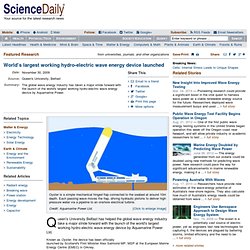
Known as Oyster, the device has been officially launched by Scotland's First Minister Alex Salmond MP, MSP at the European Marine Energy Centre (EMEC) in Orkney. ADVANCES ON THE WAVES. Aquamarine Power unveils next-generation Oyster wave energy deviceJuly 15, 2011 (PennWell via HydroWorld) "Scotland-based marine energy developer Aquamarine Power has unveiled the Oyster 800, which is the firm's [800-kW] next-generation wave energy converter…Aquamarine Power installed and grid-connected its first full-scale 315-kW Oyster at [the European Wind Energy center (EMEC)] in 2009.
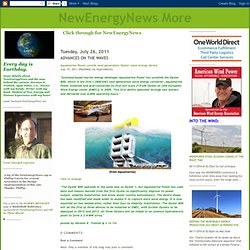
This first device operated through two winters and delivered over 6,000 operating hours. " click to enlarge "The Oyster 800 operates in the same way as Oyster 1, but Aquamarine Power has used data and lessons learned from the first Oyster to significantly improve its power output, simplify installation and allow easier routine maintenance…The device shape has been modified and made wider to enable it to capture more wave energy. Aquamarine Power : EMEC: European Marine Energy Centre.
Des vagues pour une energie renouvelable. Récemment la société Aquamarine Power (basée à Édimbourg) a dévoilé son projet pour la production d’une énergie durable : le Oyster.

Il s’agit d’une installation d’un nouveau type, pour la production d’énergie à partir des de la force des vagues et des courants marins ! Chaque unité est capable de produire 300-600kw d’électricité, ce qui signifie en d’autres termes qu’une exploitation commerciale de dix unités pourrait fournir une énergie propre pour une ville de 3000 maisons ! Le système est capable de fonctionner à faible profondeur, le rendant plus cohérent (et plus facile à mettre en œuvre, à entretenir … etc) que les systèmes qui fonctionnent au large … Le principe de fonctionnement est relativement simple. Le Si vous avez aimez cet article, vous aimerez certainement.
Aquamarine Power - Consent for first Oyster wave power array. Consent for first Oyster wave power array 14 Feb 12 - Martin McAdam, Chief Executive Officer Today Scotland's Energy Minister Fergus Ewing has given the green light on Aquamarine Power's plans for the first array of Oyster devices, by granting full consent to our 2.4 MW demonstration project in Orkney.
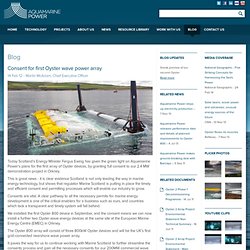
This is great news - it is clear evidence Scotland is not only leading the way in marine energy technology, but shows that regulator Marine Scotland is putting in place the timely and efficient consent and permitting processes which will enable our industry to grow. Consents are vital. A clear pathway to all the necessary permits for marine energy development is one of the critical enablers for a business such as ours, and countries which lack a transparent and timely system will fall behind. Puissance Aquamarine se concentrer sur les ondes, mais abandonner l'énergie marémotrice - Vague / marée / Hydro - Nouvelles Energies renouvelables - Recharge - éolien, solaire, biomasse, vague / marée / hydraulique et géothermique.
Oyster Wave : du pétrole à l’hydrolien. Conçue et Assemblée en Ecosse par les entreprises locales Aquamarine Power et BurntIsland Fabrication Ltd, , fournisseur des plateformes pétrolières, l'hydrolienne Oyster Wave capture l'énergie des vagues avant qu'elles ne déferlent.
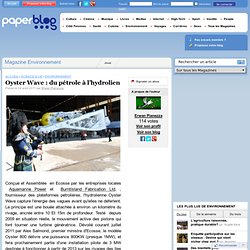
Le principe est une bouée attachée à environ un kilomètre du rivage, ancrée entre 10 Et 15m de profondeur. Testé depuis 2009 en situation réelle, le mouvement active des pistons qui font tourner une turbine génératrice. Dévoilé courant juillet 2011 par Alex Salmond, premier ministre d'Ecosse, le modèle Oyster 800 délivre une puissance 800KW (presque 1MW), et fera prochainement partie d'une installation pilote de 3 MW destinée à fonctionner à partir de 2013 sur les rivages des Iles Orcades, au Nord de l'Ecosse.
Voir aussi : le WaveHub en Cornouaille, hydrolienne Sabelle en Bretagne. L'Ecosse investit massivement dans les énergies marines renouvelables. Wave energy generator pumps power to Scotland. Wave energy got a boost with the connection of the Oyster hydro-electric device to the electricity grid in Scotland last Friday.
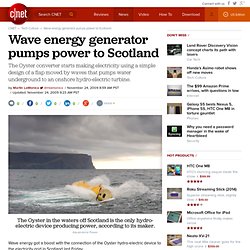
Aquamarine Power activated the connection of the Oyster in the waters off Orkney, marking one of the few ocean power devices to be producing electricity. The device is a hydraulic pump operated by a "hinged flap," where a large metal piece moves back and forth from the motion of the waves. The movement moves a hydraulic piston that pumps water underground to a hydro-electric turbine that drives a generator to make electricity. The peak power output of the Oyster 1 is about two megawatts, depending on the location. The company, which received research funding from the U.K. government, is now working on a second-generation device. There are a number of technologies being pursued to convert wave or tidal energy into electrical energy, including underwater generators.
The Oyster was tested at the European Marine Energy Centre. Nouvelles de la Science vagues union fait lumières ... Hydro-electric wave energy converter. Aquamarine Power’s innovative Oyster device is the world’s largest working hydro-electric wave energy converter.
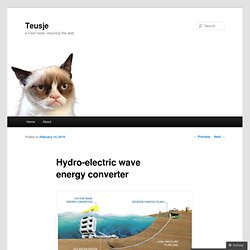
I find it really fascinating to see all these different technologies that people are trying to manufacture or invent to create “clean” energy. :) [ source ] Like this: Like Loading...